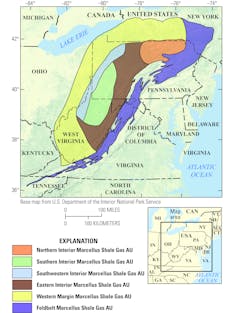The Appalachian basin contains an estimated mean of 214 tcf of undiscovered, technically recoverable natural gas in the Marcellus and Utica shale formations, the US Geological Survey reported. The estimates represented a marked increase from its previous assessments of both basins, USGS noted.
“Watching our estimates for the Marcellus rise from 2 [tcf] to 84 [tcf] to 97 [tcf] in under 20 years demonstrates the effects American ingenuity and new technology can have,” said USGS Director Jim Reilly. “Knowing where these resources are located and how much exists is crucial to ensuring our nation’s energy independence.”
The Marcellus, Point Pleasant, and Utica are extensive formations that cover parts of Kentucky, Maryland, New York, Ohio, Pennsylvania, Virginia, and West Virginia, USGS said. It estimated a mean of 84 tcf in the Marcellus shale in 2011 and about 38 tcf in the Utica in 2012.
The gas in these formations is classified as continuous because it is spread throughout the assessed rock layers instead of being concentrated in discrete accumulations, USGS said. Production techniques such as directional drilling and hydraulic fracturing are required to produce these resources, it noted.
“Since our assessments in 2011 and 2012, industry has improved upon their development techniques for continuous resources like the shale gas in the Appalachian basin,” said Walter Guidroz, who coordinates the USGS energy resources program. “That technological advancement, plus all of the geological information we’ve gained from the last several years of production, have allowed us to greatly expand our understanding of these formations.”
The Marcellus shale assessment said that the formation also contains an estimated 1.5 billion bbl of natural gas liquids, while the Point Pleasant-Utica shale assessment indicated an estimated 1.8 billion bbl of oil and 985 million bbl of NGLs, the agency said.
“Thanks to shale and production from Appalachia, the US has rapidly transformed from a nation increasingly reliant on energy imports to the global leader in natural gas production. This positive shift in America’s energy outlook continues to drive meaningful economic and environmental progress while boosting national security,” Marcellus Shale Coalition Pres. David J. Spigelmyer said in response to USGS’s announcement.
“While the US is blessed with a generational supply of clean, affordable energy, unrealistic energy policies to ban development or block critical pipeline infrastructure hurt jobs, burden consumers, and stall significant environmental gains,” Spigelmyer said.
Contact Nick Snow at [email protected].
About the Author

Nick Snow
NICK SNOW covered oil and gas in Washington for more than 30 years. He worked in several capacities for The Oil Daily and was founding editor of Petroleum Finance Week before joining OGJ as its Washington correspondent in September 2005 and becoming its full-time Washington editor in October 2007. He retired from OGJ in January 2020.
